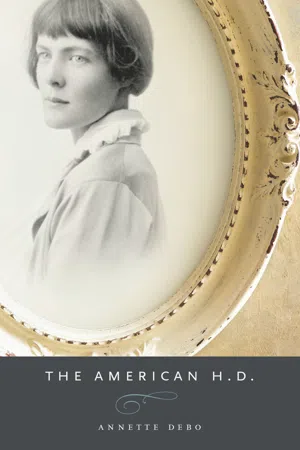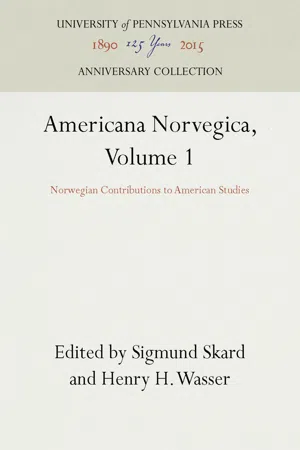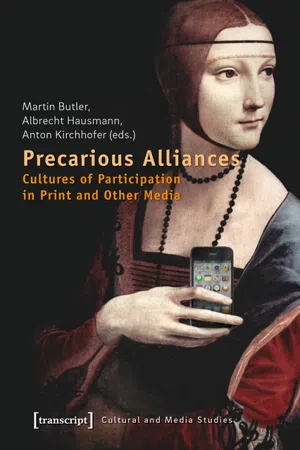Literature
American Literary Movements
American literary movements refer to the various periods and styles in American literature that have been characterized by specific themes, techniques, and ideologies. These movements include the Colonial and Revolutionary periods, Romanticism, Realism, Naturalism, Modernism, and Postmodernism, among others. Each movement reflects the social, political, and cultural influences of its time and has contributed to the rich tapestry of American literary history.
Written by Perlego with AI-assistance
Related key terms
1 of 5
4 Key excerpts on "American Literary Movements"
- eBook - PDF
- Debra A. Moddelmog, Suzanne del Gizzo(Authors)
- 2012(Publication Date)
- Cambridge University Press(Publisher)
Literary movements are always less unified, structurally and temporally, than casual critical usage would suggest, but modernism is so notoriously difficult to define that it has become traditional to speak of modernisms in the plural. 2 Noted for its avant-garde proliferation of manifestos and – isms – cubism, futurism, imagism, vorticism, dadaism, surrealism, expressionism, and so on – modernism, in its various manifestations, was nevertheless united by its artists’ self-conscious urge to, in Ezra Pound’s phrase, “make it new.” The very term modernism implies a sense of rup- ture with the immediate past, predating but exacerbated by World War I and its attendant cultural changes. But the modernists’ penchant for apocalyptic proclamations – witness Virginia Woolf’s famous declaration that “on or about December 1910 human character changed” 3 or Pound’s assertion that “the Christian era came definitely to an END” with the completion of James Joyce’s Ulysses 4 – clearly overstates the degree of this eby 174 rupture. As Edmund Wilson noted long ago, Hemingway’s brand of modernism – like the modernism of Joyce, Eliot, Pound, and Yeats – was strongly rooted in the literary movements of his immediate past – in the uneasy fusion of two opposing currents dominating Anglo-American and French literature at the turn of the century: realism and naturalism on one hand, and the symbolist and decadent movements on the other. 5 Although realism is often used as a straw man to help define what mod- ernism was not (content-driven instead of obsessed with form, directed at mimesis rather than artistic play, etc.), 6 Hemingway certainly thought of himself as both a realist and a modernist. In his classic memoir of mod- ernist Paris, Being Geniuses Together, Robert McAlmon remembers travel- ing through Spain with Hemingway in 1923: [O]n the way to Madrid, our train stopped at a wayside station for a time. - eBook - PDF
- Annette Debo(Author)
- 2012(Publication Date)
- University Of Iowa Press(Publisher)
The teaching of Americanism in schools dates from the turn of the twentieth century as part of the government’s effort to transform the millions of new immigrants into Americans, and the teaching of American literature continued to contribute to this effort by providing immigrants with examples of national character, style, and power. Gerald Graff also attributes the rise in American literature to the New Critics because the aesthetics valued by the New Critical approach facilitated linking literature to nation 7 : “The dualism and paradox that New Critics somewhat questionably attributed to poetry as such had a suspect way of reappearing in the work of Americanists as the suppos-edly unique characteristics of American literature and culture. Work after work of American literature was said to be uniquely American because of those qualities of tragic vision, moral ambiguity, psychologi-cal duplicity, and other ‘existential’ traits that New Critics attributed to great literature irrespective of nationality. All literature was New Criti-cal, it seemed, but American literature was somehow a bit more so” (220). Still, despite all of the New Critical success in theorizing about the “American” element in literature, certain critics have constantly challenged the American literary tradition—they questioned whether it was indeed a single tradition and whether it could possibly be an organic expression of the nation (Graff 220–21). These difficulties in defining just what American literature is stem from the constructed, rather than organic or innate, nature of the nation itself, returning to America’s Second Great Literary Creation Period 77 the dichotomy of nation described in the introduction: perennialist nation theory versus modern nation theory. Literary nationalism used not only literary histories to establish itself as natural, ancient, and eternal, but also literary prizes awarded specifically for excellence in American literature. - eBook - PDF
Americana Norvegica, Volume 1
Norwegian Contributions to American Studies
- Sigmund Skard, Henry H. Wasser, Sigmund Skard, Henry H. Wasser(Authors)
- 2016(Publication Date)
The time has not yet come for large scale syn-theses. But in monographic research originating within the movement there is much of obvious value. While the frontier crossing may not always seem revolutionary to European eyes, the opening of vistas is often inspiring. One may mention as a striking example John W. Ward's analysis of the Lindbergh myth. 41 In H. N. Smith's Mark Twain. The Development of a Writer (1962) the method is applied to one literary figure in a way that points far beyond the American material. And on a larger scale H. Nash Smith's Virgin Land (1950), R. W. B. Lewis' The American Adam (1955) and Leo Marx' The Machine in the Garden (1965) have given to the history of ideas a breadth and depth that is rarely equalled anywhere. The American Studies Movement 33 But so far, the movement has probably made its most weighty con-tribution in teaching. Its importance in scholarly education should not be gauged exclusively by the number of formal American Studies programs at the universities. Even more momentous may be its impalp-able influence in the much more extensive studies of American civiliza-tion that are carried on within the many traditional disciplines. At the same time the recent decades in the history of the movement have brought out, not only the inherent limitations of its theory, but also its special character in a more practical sense. The American Studies are an American creation, and in their typical form are not immediately an article of export. In many features they show the mark of that national system of education and scholarship which they have reacted against, and which has no exact counterpart anywhere else. This American experience was unexpectedly put to the test and in many ways borne out by the development of American studies in the post-war world outside of America. - eBook - PDF
Precarious Alliances
Cultures of Participation in Print and Other Media
- Martin Butler, Albrecht Hausmann, Anton Kirchhofer, Martin Butler, Albrecht Hausmann, Anton Kirchhofer(Authors)
- 2016(Publication Date)
- transcript Verlag(Publisher)
References to movements abound in the context of interpreting 282 | A NTON K IRCHHOFER individual texts as well as in the writing of literary history, they can be cen-tral to the definition and differentiation of entire periods as well as to the study of individual authors. The discourse about movements at the same time extends far beyond the sphere of academic criticism. As an example for their relevance to the public discussion of literature, I would like to quote a passage from a con-versation between Scottish novelist A.L. Kennedy and literary journalist Stephanie Merritt which was published in a British Sunday paper: AL Kennedy: … I’m a Scottish writer because I live there and I was born there, and my books will relate to other books that are Scottish, but it’s not my job to do that. That’s up to journalists, or the marketing people if they feel that will help sales by creating a Scottish movement. Observer: So you don't see yourself as part of a Scottish movement? AL Kennedy: If you talk to anybody who’s in a ‘movement’ unless they’re with An-dy Warhol or something very few artists, particularly writers, really manipulate the media and create the idea of it. I see some of the other Scottish writers sometimes, but we’re presented as always being in the pub together or sharing needles together we meet probably every two years, that's not a movement (laughs). (Merritt n.pag.) This dialogue is remarkable not least because it does not produce any tangi-ble result. Is there a “Scottish movement”? What might be its main char-acteristics? And is A.L. Kennedy part of the movement? At the end, the reader is hardly any wiser about these questions, or about the participants’ views on them. While both interlocutors accept the relevance of the issue, and both contribute to the discussion, it seems that neither the writer nor the journalist is ready to take the risk of suggesting a definitive view.
Index pages curate the most relevant extracts from our library of academic textbooks. They’ve been created using an in-house natural language model (NLM), each adding context and meaning to key research topics.



